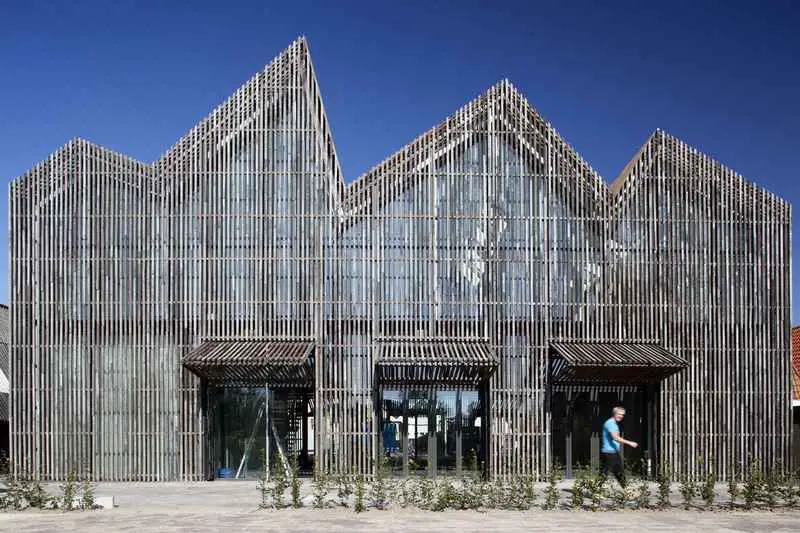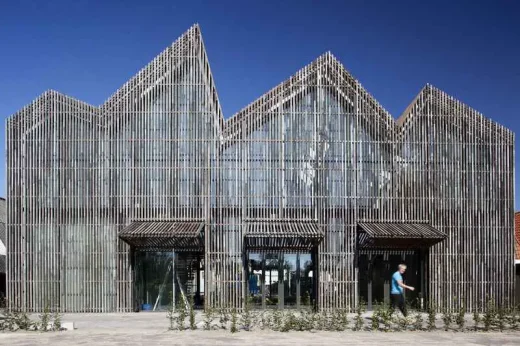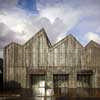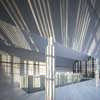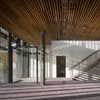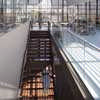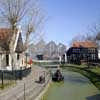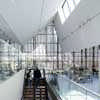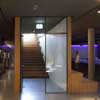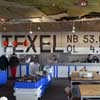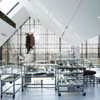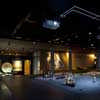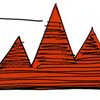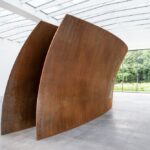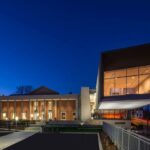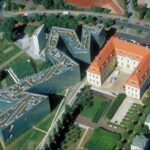KAAP SKIL Texel, Dutch Wadden Island Building, Maritime Museum Holland
KAAP SKIL, Netherlands : Texel Building
maritime and beachcombers museum Building in The Netherlands design by Mecanoo
Kaap Skil nominated for Wood Architecture Award 2012
Design: Mecanoo architecten
12 Oct 2012
KAAP SKIL Maritime Museum Award
Delft, October, 2012 – Kaap Skil, Maritime and Beachcombers Museum, on the island of Texel, the Netherlands, has been nominated for the Wood Architecture Award 2012. This bi-annual award is an initiative by the Centre for Wood, recognising new techniques and creative applications of wood in architecture.
The museum is designed with four playfully linked gabled roofs which are a play on the rhythm of the surrounding roof tops, and seen from the sea, resemble waves rising out above the dyke. The wooden facade of Kaap Skil is a good example of the time-honoured tradition of recycling. The vertical wooden strips are made of re-used hardwood sheet-piling from the North Holland Canal and have been given a new life just like the objects displayed in the museum’s collection.
The 25-year old wooden piles have been cut into strips by the local Texel sawyer Pieter Dros, yielding 10 kilometres worth. The un-sawn edges have been deliberately placed on the visible side of the facade. After 25 years of being under water the white, gray, rust red, purple, and brown colours are beautifully weathered.
From within the museum, the glass facade in front of the wooden structure allows an inviting view to the outdoor museum terrain and of the famous North Holland skies for visitors of the museum café. Inside the building the slats cast a dazzling linear pattern of shadows creating an atmosphere infused with light and shelter. Kaap Skil Maritime and Beachcombers Museum showcases a sizable collection of found objects from shipwrecks in the North and Wadden Seas.
In the museum, the public is taken back in time to the Dutch Golden Age. The showpiece of Kaap Skil is an eighteen-metre long, four-metre deep model of the ‘Reede van Texel’ (the offshore anchorage of Texel), displaying in great detail the impressive spectacle of the dozens of ships anchored off the coast of the Wadden Island.
31 May 2012
KAAP SKIL Texel Award
Kaap Skil, maritime and beachcombers museum, wins Daylight Award 2012
Design: Mecanoo architecten
Mecanoo’s Kaap Skil, maritime and beachcombers’ museum, on the Dutch island of Texel has been awarded the Daylight Award 2012. The prestigious prize, awarded by the Living Daylights Foundation, honours projects that reach an optimum result in combining daylight, artificial light and design. One can almost feel the weather because of the transparency of the building, according to the jury. “Sun, clouds, thunder and rain: outdoors comes inside as perception and emotion and this is a core quality for a building with the Wadden Sea at your doorstep.”
Kaap Skil plays with daylight and the contrast between daylight and artificial light, lightness and darkness in various ways. The glass facade in front of the wooden boards affords an inviting view of the famous North Holland skies to visitors of the museum café. Inside the building, these boards cast a linear pattern of daylight and shadow creating an atmosphere infused with light and shelter.
The showpiece of the museum is an eighteen-metre long, four-metre deep model of the Reede van Texel in the basement, displaying in great detail the impressive spectacle of the dozens of ships anchored off the coast of the Wadden Island during the Golden Age. In that period the fleet of the Dutch East India Company would set its anchor at the Reede van Texel before sailing off to the ‘Orient’. Visitors are drawn around the Reede van Texel by projections and animations, creating an intimate space that harbours a sense of mystery. On the first floor the sky floods the objects on display with light.
The movable showcases of robust steel frames and glass create a transparent effect so that the objects in the collection seem to float within the space. The beams which pierce the skylights of the high gabled roofs give visitors the feel of being under water. The interior of the museum and the two exhibitions are designed by Kossmann.dejong from Amsterdam.
KAAP SKIL museum on Texel images / information from Mecanoo
28 Mar 2012
KAAP SKIL Texel
KAAP SKIL museum on Texel
Design: Mecanoo architecten
Delft, 28 March, 2012
Opening KAAP SKIL, maritime and beachcombers museum, on Dutch Wadden Island of Texel
Friday 30 March 2012, KAAP SKIL, maritime and beachcombers museum, on the Dutch Wadden Island of Texel will open its doors. In addition to two new exhibitions, the museum building designed by the Dutch office Mecanoo architecten, will house a café and offices. The audience of KAAP SKIL is taken 400 years back in time, when the fleet of the Dutch East India Company would set its anchor at the ‘Reede van Texel’ (the offshore anchorage of Texel) before sailing off to the ‘Orient’. The showpiece of the museum is an eighteen-metre long, four-metre deep model of the Reede van Texel, displaying in great detail the impressive spectacle of the dozens of ships anchored off the coast of the Wadden Island.
The museum in Oudeschild stands out with its four playfully linked gabled roofs which are a play on the rhythm of the surrounding roof tops. The wooden façade of Kaap Skil is a good example of the time-hallowed tradition of recycling. For hundreds of years the people of Texel have made grateful use of driftwood from stranded ships or wrecks to build their houses and barns.
The vertical wooden boards of KAAP SKIL’s facade are made of sawn hardwood sheet-piling from the North Holland Canal and have been given a new life just like the objects in the museum collection. From within, the glass facade in front of the wooden boards allows an inviting view of the outdoor museum terrain and of the famous North Holland skies to visitors of the museum café. Inside the building the boards cast a linear pattern of daylight and shadow creating an atmosphere infused with light and shelter.
In the basement, visitors are drawn around the Reede van Texel by projections and animations, creating an intimate space that harbours a sense of mystery. On the first floor the North Holland sky floods the objects on display with light. The movable showcases of robust steel frames and glass create a transparent effect so that the objects in the collection seem to float within the space. The interior of the museum and the two exhibitions are designed by Kossmann.dejong from Amsterdam.
Kaap Skil, Maritime and Beachcombers Museum, Texel, the Netherlands
tourist attraction
The island of Texel is situated in the Waddenzee and is the largest of the Dutch Wadden Islands. Every year a million or so tourists visit the island, which is only accessible by plane, boat or ferry. Few however will be familiar with the glorious history of Texel and its links with the Dutch East India Company.
In the seventeenth and eighteenth centuries the Company’s fleet used the anchorage of Texel as its departure point for expeditions to the Far East. The ships waited there for a favourable wind before weighing anchor and sailing off to the ‘Orient’. While they waited, maintenance work and small repairs were carried out, victuals and water were brought on board and family could see their loved ones one last time.
Many painters visited the ‘Reede van Texel’ (the offshore anchorage of Texel) to depict on canvas the fleet of the Dutch Republic. In the new entrance building of the maritime and beachcombers museum, Kaap Skil, in the hamlet of Oudeschild, the public is taken back in time to the Dutch Golden Age. The showpiece of the museum is an eighteen-metre long, four-metre deep model of the Reede van Texel, displaying in great detail the impressive spectacle of the dozens of ships anchored off the coast of the Wadden Island.
typical gable roofs
The museum is designed with four playfully linked gabled roofs which are a play on the rhythm of the surrounding roof tops which, seen from the sea, resemble waves rising out above the dyke.
‘The sea takes away and the sea provides’ – this is a saying that the people of Texel know so well. For hundreds of years they have made grateful use of driftwood from stranded ships or wrecks to build their houses and barns. The wooden façade of Kaap Skil is a good example of this time-hallowed tradition of recycling.
The vertical wooden boards are made of sawn hardwood sheet-piling from the North Holland Canal and have been given a new life just like the objects in the museum collection. From within, the glass facade in front of the wooden boards allows an inviting view of the outdoor museum terrain and of the famous North Holland skies to visitors of the museum café. Inside the building the boards cast a linear pattern of daylight and shadow creating an atmosphere infused with light and shelter.
daylight and artificial light
The entrance and the museum café form a natural frontier between the world of the Reede van Texel in the basement and that of the underwater archaeology on the first floor. The contrast between the two worlds is reinforced by the different experiences of light and space. In the basement visitors are drawn around the exhibition by projections and animations, creating an intimate space that harbours a sense of mystery.
On the first floor the North Holland sky floods the objects on display with light. The movable showcases of robust steel frames and glass create a transparent effect so that the objects in the collection seem to float within the space. Under the high gabled roofs the visitor gets a generous sense of being able to survey the sizable collection, the museum grounds and the village of Oudeschild at a glance.
Kaap Skil Museum – Building Information
Programme: 1,200 m² museum building with exhibition galleries, café and offices Design period: 2007-09
Construction period: 2010-11
Client: Maritiem & Jutters Museum, Oudeschild
Architect: mecanoo architecten, bv
Museum design: Kossmann.dejong, Amsterdam
Project management: ABC Management Groep, Assen Builders: Pieters Bouwtechniek, Utrecht
Installations consultant: Peter Prins, Woerden
Contractors: Bouwcombinatie De Geus & Duin Bouwbedrijf, Broek op Langedijk
Installations: ITBB, Heerenveen
Sawmills for wooden cladding of façades: Pieter Dros, Texel
KAAP SKIL museum on Texel images / information from Mecanoo
Location: Texel, Netherlands
Architecture in The Netherlands
Contemporary Dutch Architecture
Netherlands Architecture Designs – chronological list
Amsterdam Architecture Walking Tours by e-architect
Dutch Architect – design firm listings
Dutch Architecture – Recent Selection
Tij Bird Observatory, Scheelhoek
Architects: RO&AD Architecten
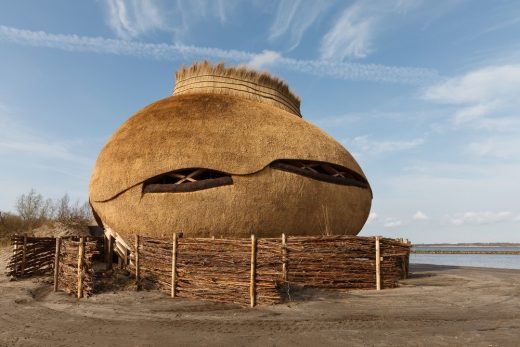
photography : Katja Effting
Tij Bird Observatory in Scheelhoek
Eurojust Building
Mecanoo / Haskoning
Eurojust Building The Hague
City Hall + Cultural Center in Nieuwegein
3XN Architects
City Hall + Cultural Center in Nieuwegein
MVRDV, Architects
MVRDV Glass Farm
Comments / photos for the KAAP SKIL museum on Texel page welcome

